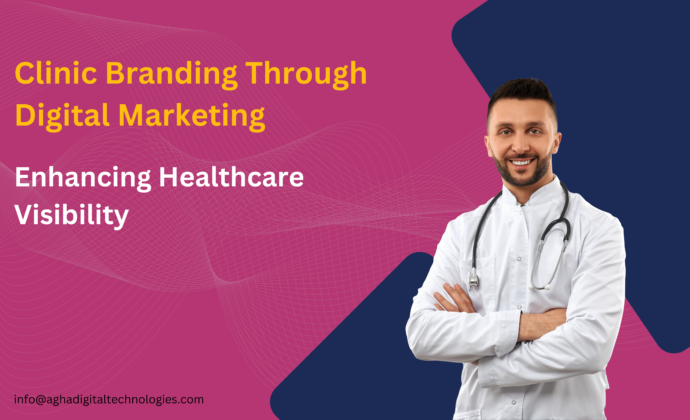Clinic Branding Through Digital Marketing – Enhancing Healthcare Visibility

In today’s digitalized world, customers increasingly turn to online sources for all their needs, including finding quality healthcare. While doctors and clinicians have always relied on word-of-mouth, building a thriving practice is needed. To attract new patients and stay relevant in this interconnected landscape, clinics must establish an engaging online presence. It involves harnessing the power of digital marketing to raise visibility, build trust, and distinguish the brand in the healthcare space. When done correctly using strategic channels, digital branding can substantially boost a clinic’s reach and reputation. This article provides an overview of various best practices clinics can adopt to promote themselves effectively through digital platforms.
Understanding Clinic Branding in the Digital Era
Branding lays the foundation of any successful business by memorably communicating the unique value proposition. Establishing an identifiable brand in healthcare becomes even more critical amidst numerous options. Patients researching treatment options need clarity on what differentiates one clinic from others. It is where digital becomes pivotal – it allows clinics to showcase their specialties, expertise, and philosophy of care to a vast online audience. Crucial elements like logos, colors, fonts, brand story, and messaging need consistency across all virtual touchpoints. Clinics must curate online platforms highlighting their USPs compellingly for searchers. Investing in a solid, differentiated digital brand drives greater credibility and draws qualified patients organically over time.
Clinic branding in the digital age involves crafting a distinctive identity that resonates with patients and sets a healthcare facility apart in a crowded market. It’s about establishing a unique voice, values, and image that reflect the quality of care and patient experience. In the digital era, this branding extends beyond logos and slogans; it encompasses online reputation, patient reviews, and the overall digital footprint. Ensuring consistency across all digital platforms reinforces the clinic’s brand and fosters trust and recognition among current and potential patients.
Optimizing the Clinic Website
A professionally designed, optimized website serves as any clinic’s digital headquarters. It should impart the brand identity clearly while addressing patient needs. A clinic’s website serves as its digital front door. Optimization involves:
- Creating a user-friendly interface.
- Ensuring mobile responsiveness.
- Providing relevant and easily accessible information.
It’s imperative to optimize for search engines, incorporating relevant keywords, meta tags, and structured data to improve visibility and rank higher in search results. Moreover, a well-optimized website enhances patient experience and builds credibility and trust, driving conversions and patient engagement.
Some tips for an effective clinic website:
- Use clear, customer-centric language and avoid technical jargon.
- Include high-quality photos/videos depicting services and user-friendly infrastructure.
- Highlight practitioner profiles with qualifications, experience, and specialties.
- Provide service details along with pricing transparency on popular treatments.
- Feature patient testimonials and credential highlights for credibility.
- Give easy booking options integrated with online calendars.
- Maintain helpful resources like health articles, guides, and FAQs.
- Optimize for all devices and ensure seamless navigation on mobile.
- Focus on user experience with speed, visual appeal, and content organization.
Investing in professional website design and search engine optimization helps clinics rank higher and attract more qualified website traffic.
Leveraging Social Media Engagement
Social media platforms offer clinics an interactive space to engage with patients, share valuable content, and humanize the practice. Building a solid social media presence involves:
- Consistent posting of informative and engaging content.
- Responding to patient queries promptly.
- Showcasing the clinic’s expertise.
By leveraging various social media channels strategically, clinics can build a community, foster patient loyalty, and amplify their brand reach.
Social media platforms are ideal brand awareness and relationship-building tools for healthcare facilities. The critical networks for clinics are:
Facebook – Ideal for regular posts on new services, packages, tips, and upcoming events to engage local audiences.
Instagram – Great for photographic content depicting services, modern infrastructure, and happy patients/staff.
YouTube: Clinics can effectively produce short explainer videos, doctor interviews, and testimonial videos here.
Twitter – Allows broadcasting critical updates for followers and interacting with patient queries directly.
LinkedIn – Clinics can showcase expertise, services, and jobs and engage with other healthcare professionals here.
Consistent posting of high-quality, relevant, and visually appealing content is vital for communities to grow and sustain their online presence over time.
Pursuing Local Search Engine Optimization
Local SEO focuses on optimizing a clinic’s online presence for location-based searches. This involves creating and maintaining accurate business listings across online directories, encouraging patient reviews, and geo-targeting keywords. Prioritizing local SEO tactics ensures that when potential patients search for healthcare services in the clinic’s vicinity, they find accurate and compelling information, increasing the likelihood of converting online searches into clinic visits. Since most patients search locally for nearby care providers, optimizing for local search engines like Google My Business/Maps becomes essential. Clinics should claim their business profiles accurately with the following:
- Detailed practice information, operating hours, and services.
- High-resolution logo and images of the facility, doctors, and procedures.
- Answered Q&As and positive consumer reviews where feasible.
- Consistent business category listings across search engines.
- Well-optimized web page with local-focused keywords.
- Utilizing local listing advertisements for greater visibility.
Proper tracking and responding to consumer queries and reviews helps enhance credibility in local search results. Over time, it builds a reputation as a preferred neighborhood healthcare provider.
Tapping Paid Digital Advertising
Paid digital advertising, such as pay-per-click (PPC) campaigns, allows clinics to target specific demographics and reach potential patients actively seeking healthcare services. It’s a cost-effective way to boost visibility, drive website traffic, and generate leads. Targeted ads on search engines and social media platforms enable clinics to tailor messages, maximize ad spend, and track performance metrics to refine their marketing strategies. For quicker results, clinics can leverage cost-effective paid digital marketing to drive targeted traffic. Popular options are:
- Google Ads – Clinics can promote keywords related to their services location-wise.
- Facebook/Instagram Ads – Reach desired demographics through interests and behaviors for awareness.
- Programmatic Display Ads – Engage audiences across affiliated health information websites.
- Search Retargeting – Re-engage past website visitors through related ads network-wide.
- Local Business Listing Ads – Feature on local maps/sites by paying for visibility upgrades.
Ad budgets should match clinic goals with daily spending and performance tracking for optimization. Professional advisors help design campaigns effectively.
Partnering with Referral Sources
Collaborating with referral sources, such as other healthcare providers, local businesses, or community organizations, can significantly impact a clinic’s patient acquisition. Establishing strong relationships and networks within the healthcare community fosters mutual referrals and enhances the clinic’s reputation. These partnerships expand the clinic’s reach and credibility, driving a steady stream of qualified patient referrals. Building and nurturing these relationships remain crucial in sustaining a robust patient base and fostering a thriving practice. Collaborating with complementary healthcare providers cultivates new patient sources organically. Clinics can approach:
- Primary care physicians and family doctors for specialist referrals and vice-versa.
- Health insurance brokers/agents recommending trusted in-network providers.
- Nearby pharmacies and allied health centers complement specific services.
- Community event organizers for sponsorships building brand visibility.
- Local blogs/portals covering health and wellness topics as content partners.
By establishing themselves as reliable and qualified partners, clinics diversify their referral networks and reach systematically through shared brand exposure. Mutually beneficial tie-ups cement long-term growth.
Some Success Stories
Here are examples where clinics effectively used digital marketing to gain traction:
A fertility clinic leveraged local SEO and Google ads to grow its customer base by 30% despite new local competitors entering.
An eye hospital posted helpful goggles-free videos on Instagram, accumulating over 10K followers and driving higher in-person consultations.
A skin and hair clinic revamped its website, focusing on user experience, and saw new patient bookings double within a year through organic searches alone.
A physiotherapy center promoted arthritis treatment packages through Facebook groups, gaining new long-term patients from hyper-local targeting.
These real-world instances attest to how a comprehensive digital branding strategy centered around patients can deliver tangible results for ambitious medical practices.
Enhancing Healthcare Visibility
Enhancing healthcare visibility involves strategies to increase a healthcare facility’s presence and recognition within its target market. This visibility ensures that the facility is easily found, known, and considered when individuals seek healthcare services.
Digital Presence and Online Reputation Management
A significant aspect of healthcare visibility is maintaining a robust digital presence. This encompasses having a user-friendly website and managing online reviews, social media engagement, and directory listings. Optimizing the facility’s website for search engines enhances its visibility in search results, ensuring it appears when potential patients look for relevant healthcare services. Managing online reviews and engaging with patients on social media builds trust and credibility, contributing to a positive online reputation.
Community Engagement and Education
Engaging with the local community through health education programs, workshops, or partnerships with local organizations is crucial for healthcare visibility. Participating in community events, hosting health-related seminars, or providing resources for health education serves the community and establishes the healthcare facility as a trusted resource. This fosters a sense of connection and loyalty within the community while increasing visibility.
Physician Referral Networks
Building and maintaining strong relationships with referring physicians and specialists is pivotal for healthcare visibility. Referral networks rely on mutual trust and confidence in the quality of care the healthcare facility provides. Regular communication, collaboration on patient care, and feedback mechanisms strengthen these relationships, leading to increased referrals and visibility within the medical community.
Public Relations and Marketing Initiatives
Strategic public relations and marketing efforts play a crucial role in healthcare visibility. Crafting compelling stories, sharing successful patient outcomes, and highlighting the expertise of healthcare professionals through various media channels can significantly enhance visibility. This includes press releases, media interviews, and targeted marketing campaigns that communicate the facility’s unique strengths and services to the broader audience.
Quality of Care and Patient Experience
Ultimately, providing exceptional quality of care and an outstanding patient experience is the cornerstone of sustained healthcare visibility. Positive patient experiences lead to word-of-mouth recommendations, testimonials, and online reviews, all contributing significantly to the facility’s reputation and visibility in the healthcare market. Consistently delivering high-quality care fosters patient loyalty and attracts new patients, enhancing community visibility and credibility.
Conclusion
In today’s digital healthcare landscape, establishing an identifiable online presence is non-negotiable for any growing clinic. By thoughtfully leveraging various digital marketing channels, medical facilities can build more robust brand recognition, trust, and visibility within their key communities. Engaging digital brand identity and valuable online content set clinics apart and organically draw quality patient traffic over time. Those investing regularly in digital strategy and optimization will enjoy sustainable competitive advantages over others, fueling long-term practice growth.
 Free Consultation
Free Consultation



